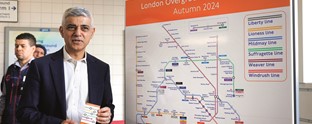Five minutes with Tom Bellamy

Tom Bellamy, executive creative director at SocialChain, talks about the power of embracing a creator-led approach to engaging audiences across digital platforms and how, as an agency, they were able to bring the gameplay of BBC’s ‘The Traitors’ to life on TikTok.
There’s been much discussion about the role of creators within social media, with some in the creative industry saying that they should be part of every brief. At SocialChain, you go further in your creator-led agency model. Can you tell me a little more about what this means?
The world of social moves quickly. In this way, it’s unlike any other communications channel. As a result, the traditional agency models are creaking under the strain of delivering at the speed necessary to be effective in this space. While this may leave creative agencies feeling slightly threatened, they have much to gain from adapting to this landscape. Moving forward, successful agencies will understand that great ideas are no longer restricted to the creative department. In many cases, they’re not even happening in the same building.
The shift is down to the creator economy and the new generation of creatives. Armed with just a phone, they are rightly being recognised for the clever, creative and just as meaningful work they do. Their ability to take a real command of a story and specialist subject means their content is authentic and compelling. Moreover, with their understanding of the community surrounding their passion, they can think about the people they’re talking to rather than whether they are showing up on TikTok, Instagram, or X and so on. This is because they are simply doing what they love.
However, this doesn’t mean that we can’t change the way we work in an agency to achieve the authenticity that comes from creators through a creator-led approach. A great idea can come from anywhere and anyone. In other words, a person doesn’t need to have ‘creative’ in their job title in order to be creative. Flattening the creative hierarchy will allow for unlocking hidden specialisms within the wider team - instilling the idea of true collaboration internally. After all, who knows what talents lie hidden within the agency?
With creators at the heart, agencies will be better equipped to deliver great ideas in real time while having the ability to adapt and flex around problems to find purpose-built solutions. This approach must be the new normal to be successful.
How did the use of creators enable you to bring the unique and compelling gameplay of a new programme format – such as The Traitors – to life in the digital space?
First, a little context around The Traitors. The reality game show sees 22 strangers enter a castle, with a small group secretly designated as traitors while the others are faithfuls. The faithfuls must then seek out the traitors and banish them, while the traitors must avoid detection as they 'murder' faithfuls each night. With a huge £120,000 on the line for the last-standing contestant, it's certainly high stakes (and a must-watch).
We knew this jeopardy must be added to bring the campaign to life. We started with coordinating a cohesive story arc across multiple creators for one campaign. Our TikTok activation reflected the show’s gameplay, with each chosen creator competing as Faithfuls or Secret Traitors attempting to sabotage the game.
Using TikTok-native platform features, we brought the whodunnit-style format to our midweight talent with an average following of over 800k. Our four creators – @formzofficial, @nohailchooch, @danispeaks and @itssarahgordon – participated in their challenge to uncover the traitor among them, encouraging their audiences to comment on their guesses and theories – and, of course, to watch The Traitors on BBC iPlayer.
By bringing the strengths of multiple creators together, we could organically reach a huge audience of 3.2 million. Additionally, the authenticity of the creative led to over 8,000 engagements and 100+ comments expressing support for the campaign or interest in campaign gameplay. It demonstrates the power of creators. This kind of engagement would not come from an ad banner, for example. It just doesn’t open the narrative or have the same level of interactivity.
What were the challenges and key learnings of creating a digital identity and ‘brand’ persona through the use of creators for a new game show format on a digital platform such as TikTok?
Since The Traitors was an entirely new format, it didn’t have an engaged audience, which was the main challenge. But it’s one that creators naturally solve. The Traitors may not have an established audience, but our four creators did. The key advice would be to work closely with them by embracing their approach to work, problem-solving and narrative structures. They know what works with their audience, which is a tool to wield.
Forcing ‘brand’ messaging with creators won’t work because you lose the authenticity that makes a creator-led approach so powerful in the first place. Take the added time to understand, learn and collaborate. This will create more effective work that truly lands with the required audience. So, rather than supplying a brand messaging script, think of more natural ways to develop a strong affinity with a brand. With The Traitors, for example, we shot the first deliverable at the press launch event for the series with none other than The Traitors’ beloved host, Claudia Winkleman. In other words, bring in – and use – the brand’s key, memorable selling points that will resonate with audiences. This gives audiences an accessible entry point, even if the format is something they haven’t seen before.
In TikTok, in particular, several ad formats can be utilised. Our creators posted 13 separate TikTok assets over a period of five days, including feed posts, Stitches and platform-native filters. Despite The Traitors being for a streaming service, the campaign felt very social-first and TikTok native. However, always remember “people before platforms”. This strategy worked well because it was creator-led, not because TikTok offers these features. The creators know how to use a platform’s formats to add to the broader social conversation, thus creating an impactful and engaging campaign for the brand.













